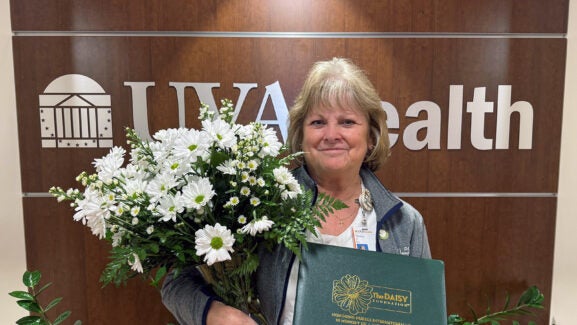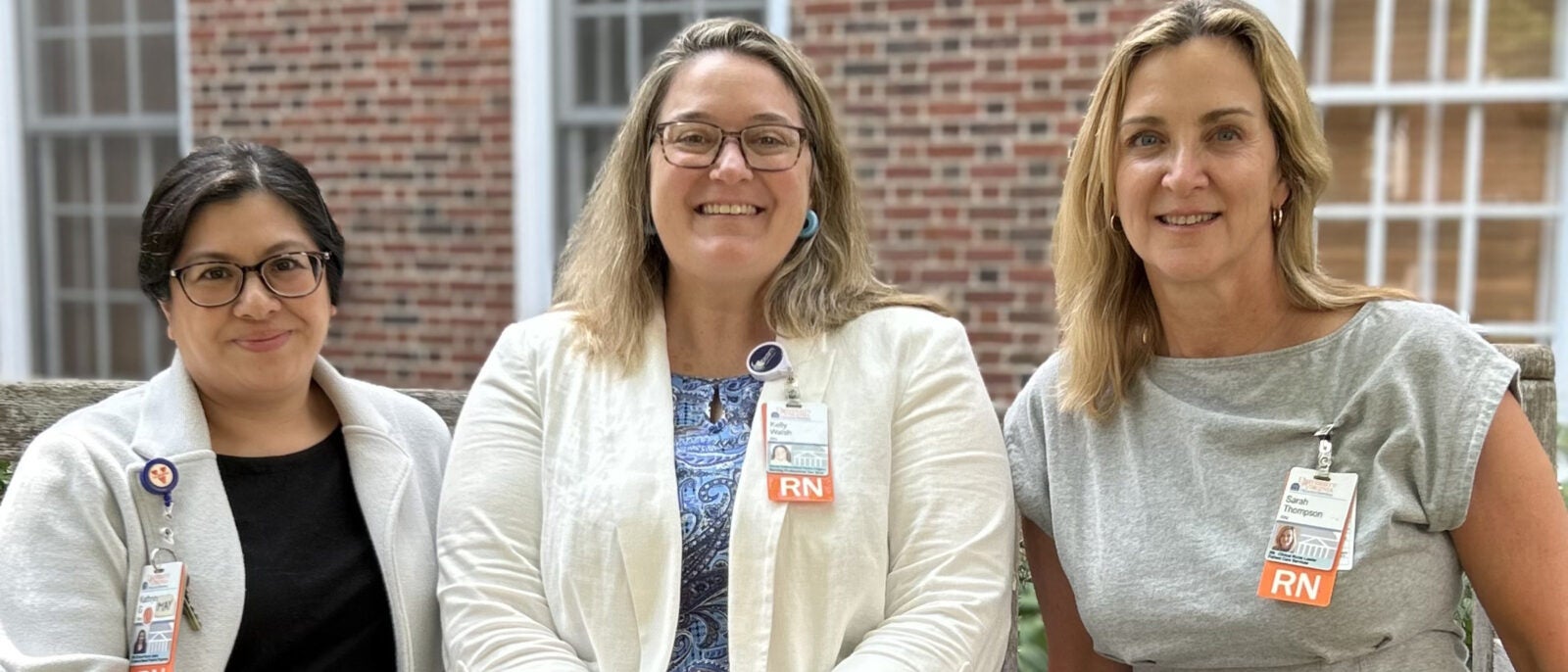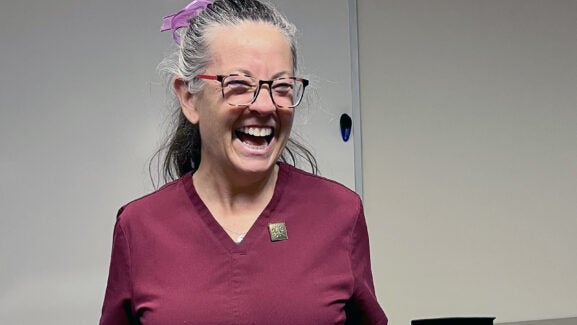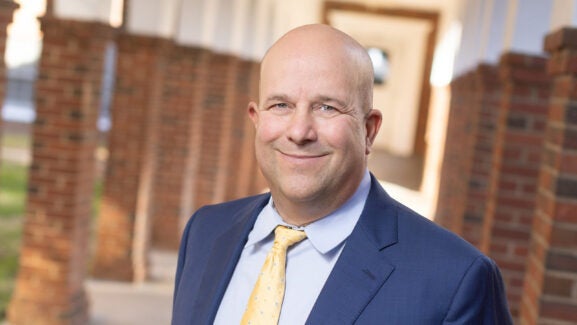

From left: Kelly Walsh, MSN, RN, CNL; Sarah Thompson, MSN, RN, CNL, RNC-OB; and May Gallanosa, DNP, RN, FNP-BC, CNL.
‘A Visionary Shift’: How UVA Health’s Ambulatory CNLs Are Improving Nursing Practice and Patient Care
“The ambulatory CNL model touches every pillar of our nursing strategic plan — superior patient outcomes, workforce strength, easy access, and best place to work.”
— Rachel Nauman, DNP, RN, NEA-BC, Director, Ambulatory Nursing
Long seen as a vital role in inpatient settings, the master's-prepared Clinical Nurse Leader (CNL) is rarely found in outpatient care and is rarely a standalone role — not embedded in other roles. But UVA Health is changing that.
“The goal of the CNL is to elevate nursing practice and improve patient outcomes,” says Kelly Walsh, MSN, RN, CNL, Director, Evidence-Based Practice (EBP) programs. “They work with nurses on patient safety, risk reduction, quality improvement, EBP application, staff satisfaction, and more.”
UVA Health began implementing the CNL role two years ago, and now has CNLs in Women’s, Children’s, Inpatient Adult, and Ambulatory. “Our CNLs are collaborators, facilitators, and quarterbacks for the nursing team. They translate big-picture initiatives into actions that are meaningful in the clinic space. I have not heard of any other health systems doing this in outpatient care. I think we’re forging the way.”
Customizing the CNL Role for the Ambulatory Environment
CNLs are often described as system translators — professionals who bring together data, evidence, clinical trends, and nursing practice to drive improvements where it matters most: at the front lines of care. But applying that model in outpatient settings has required innovation. “We’ve had to customize the ambulatory CNL role,” says Walsh. “And I don’t think it would be as successful as it has been if it weren’t for our team’s understanding that this is a new role. They’re implementing it, staying agile, and adapting it as we go.”
Unlike inpatient CNLs who often work on a single unit, UVA’s ambulatory CNLs cover “tremendous” scopes and multiple clinics, sometimes spanning specialties like allergy, pulmonary, infectious disease, and women’s health. “Our CNLs are working across microsystems, but also thinking at the mesosystem level,” says Rachel Nauman, DNP, RN, NEA-BC, Director, Ambulatory Nursing. “They’re looking at our clinical data, quality metrics, outcomes, and interventions, and helping us move the dial.”
“It takes a village to do this work,” adds Karin Skeen, PhD, RN, NEA-BC, UVA Health University Medical Center Associate Chief Nursing Officer. “It wouldn't have happened if we didn’t have all the right people lined up to think through the scope of the CNL, the timing, and how we were going to get everything done.”
A Visionary Shift in Ambulatory Nursing
Traditionally, outpatient care has been provider-centric, with nursing sometimes taking a backseat. But as patients become more medically complex, and more care shifts to outpatient settings, the nursing role is expanding — and CNLs are helping to lead that evolution. “There’s a perception that nursing isn’t as prominent in ambulatory,” says Nauman. “But the reality is we’re doing more procedures, more complex education, more care coordination than ever before. CNLs help us ensure that care is high quality, patient-centered, and efficient.”
The need is especially great in UVA Health's far-reaching network of outpatient clinics, which span the region and state, as far as Page County. “We’re not all in one big building like with inpatient,” says Nauman. “It’s been hard to conceptualize the CNL role in a space that is so dispersed, but technology like Zoom and Teams has made it easier, and we worked hard to recruit the right people.”
Rooted in Partnership With UVA School of Nursing
There are currently three ambulatory CNLs at UVA Health: May Gallanosa, DNP, RN, FNP-BC, CNL; Emily Brady, MSN, RN, CNL; and Sarah Thompson, MSN, RN, CNL, RNC-OB. All are graduates of UVA School of Nursing’s CNL program, which recently celebrated its 20th anniversary. “That academic partnership has been a direct pipeline for us,” says Nauman. “We’ve been really lucky that we found the right people to do this work — people who are rooted in the community and committed to UVA Health.”

Walsh agrees: “They’re strong nurses with varied backgrounds, and they’re part of the clinic-based leadership team. They’re at the table with providers, nurse leaders, and access managers.”
For Thompson, the impact of the role is clear. “There are so many moments when a manager — who is giving their all to their patients and staff — tells me they have the data, the training, the evidence-based process improvement, the safety initiative, the report, or the support I provided, and it made their life easier and improved patient care,” she says. “Knowing I add value and support positive change is extremely rewarding.”
That kind of impact is already evident across ambulatory clinics. Recent CNL-led projects include:
- Reduced vaccine administration errors by more than 80% in primary care through process improvement.
- Enhanced electronic health record (EHR) integration to support consistency across clinics.
- Improved early pregnancy loss care processes in women’s health.
- Consulting with clinical analytics to create a nurse visit report that highlights the value and scope of work being done by ambulatory nursing clinical staff.
Gallanosa, who covers primary care and behavioral health and led the vaccine administration project, says involving a multidisciplinary team was key to its success: “We involved many family medicine and pediatric nursing team members, a physician, pharmacists, the director of ambulatory clinical professional development, a Clinical Nurse Specialist, and a performance improvement coach.”
Using a lean approach, Gallanosa and team tracked vaccine-related events through Be Safe reporting data and implemented a standardized approach to vaccine administration, which included enrolling staff in educational modules — creating a competency verification record inclusive of a clinical workflow, and utilizing a vaccine champion model in clinics.
“These are broad projects that affect many clinics,” says Walsh. “We often start with a high-need area and then think about how to expand it systemwide. That’s the kind of systems-thinking our CNLs bring.”
A Cultural Shift Aligning With a Broader Strategy
Skeen says the ambulatory CNL initiative is part of UVA Health’s nursing strategic plan under UVA Health University Medical Center Chief Nursing Officer Kathy Baker, PhD, RN, NE-BC, and is about aligning the right work with the right roles.
“Historically, far more resources have gone into inpatient care because it’s just an insatiable beast,” Skeen says. “But when you stop and back up, you realize that if we invest in ambulatory care, we can keep people out of the hospital, get them home sooner, and keep them healthier.”
She credits Nauman and Walsh with helping advance this shift. “Rachel has been instrumental in defining what quality work in ambulatory looks like and aligning our resources to support it. And with Kelly’s expertise around the CNL role in particular, she has been able to determine how it fits into ambulatory and help with the quality piece.”
The team is recruiting for CNLs at UVA Health Children’s and expects to expand from there. “We will need many more of these nurses,” explains Nauman. “They are the voice of the patient and the voice of the nurse. And they’re helping us deliver the kind of world-class care UVA Health is known for.”
New CNL Hires Show the 'Why'
Not every health system understandings the value Clinical Nurse Leader positions bring. But UVA Health does.
Latest News



